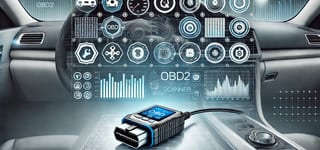What is the difference between an OBD and OBD2 scanner?

If you regularly deal with cars, you have probably come across the terms OBD and OBD2. These scanners are essential for reading car faults, but what exactly is the difference between an OBD and an OBD2 scanner? And which one do you need for your vehicle?
What is an OBD scanner?
Let's start with OBD, which stands for On-Board Diagnostics. This system was introduced in the 1980s to detect vehicle problems faster and more efficiently. An OBD scanner allows you to read data from your car, such as fault codes and engine performance.
One of the biggest features of OBD scanners of the time was that they were vehicle-specific. This meant that each car manufacturer had its own system, and a scanner for a Ford would not simply work on an Opel. Pretty awkward, right?
What is an OBD2 scanner?
This is where the OBD2 scanner comes in. In 1996, OBD2 became the standard for all US-manufactured vehicles. Europe followed in 2001 for petrol cars and in 2004 for diesel cars. So OBD2 scanners work on almost all modern vehicles, regardless of make or model. This not only makes them more versatile, but also more user-friendly.
An OBD2 scanner can not only read out fault codes, but also monitor live data from the car. Think, for example, of speed, fuel consumption or pollutant emissions. In addition, the fault codes displayed by OBD2 are standardised, meaning you will get the same fault code no matter what make of car you are in.
Summary of differences:
| Feature | OBD Scanner | OBD2 Scanner |
|---|---|---|
| Year of introduction | 1980s | 1996 (US), 2001/2004 (Europe) |
| Vehicle compatibility | Vehicle-specific | Works on almost all vehicles after 1996 |
| Error codes | Specific per brand | Standardised codes for all brands |
| Functionality | Basic error code reading | More extensive: reading out and monitoring live data |
Which scanner do you need?
If you have a pre-1996 vehicle, you may need an old OBD scanner specific to your make of car. However, if you have a post-1996 car (or after 2001/2004 in Europe), then an OBD2 scanner is the best choice. These are more versatile, easier to use and provide more detailed information.
At OBDWarenhuis, we offer a wide range of OBD2 scanners, suitable for hobbyists and professional mechanics alike. Whether you simply want to read out fault codes or dive deeper into the technical details of your car, we have the right scanner for you.
Conclusion
The main difference between OBD and OBD2 scanners is compatibility and functionality. While OBD was mainly proprietary and could only read basic fault codes, OBD2 is a standardised system that offers much more information. For most modern vehicles, an OBD2 scanner is the right choice, and at OBDWarenhuis, we are happy to help you find the right scanner.
Ready to get started? Check out our range of OBD2 scanners and find out which scanner best suits your needs!
